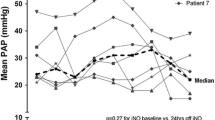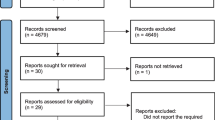Abstract
Pulmonary hypertension is one of the most challenging complications in congenital heart surgery. The purpose of this study was to characterize inhaled nitric oxide administration in children with and without pulmonary hypertension who underwent congenital heart surgery and to describe the effect of nitric oxide administration on admission outcomes. This is a cross-sectional study utilizing data from the Pediatric Health Information System (PHIS) and PHIS + databases from 2004 to 2015. Pediatric patients with a congenital heart disease diagnosis were included and divided into groups with pulmonary hypertension that received and not received inhaled nitric oxide and patients without diagnosis of pulmonary hypertension who received and did not receive inhaled nitric oxide. For all admissions, the following were captured: age of admission, gender, year of admission, length of stay, billed charges, inpatient mortality, the presence of specific congenital malformations of the heart, specific cardiac surgeries, and comorbidities. Comparisons between groups were completed using a Mann–Whitney-U test and Fisher’s exact test. Outcomes evaluation was completed using univariate and regression analyses. A total of 40,194 pediatric cardiac surgical admissions without pulmonary hypertension were identified. Of these, 726 (1.8%) received inhaled nitric oxide. Regression analyses demonstrated that inhaled nitric oxide was independently associated with increased length of stay, billed charges, and inpatient mortality. A total of 1678 pediatric cardiac surgical admissions with pulmonary hypertension were identified. Of these, 195 (11.6%) received inhaled nitric oxide. Regression analyses demonstrated that inhaled nitric oxide was independently associated with a significant increase in length of stay and billed charges. There was no statistically significant association between inhaled nitric oxide and decrease mortality. Administration of inhaled nitric oxide after pediatric cardiac surgery increases length of stay and billed charges while not providing improved inpatient mortality. In fact, administration of inhaled nitric oxide was associated with increased mortality in those without pulmonary hypertension while not impacting mortality in any way in those with pulmonary hypertension.

Similar content being viewed by others
References
Bando K, Turrentine MW, Sharp TG, Sekine Y, Aufiero TX, Sun K, Sekine E, Brown JW (1996) Pulmonary hypertension after operations for congenital heart disease: analysis of risk factors and management. J Thorac Cardiovasc Surg 112:1600–1607; discussion 1607–1609
Adatia I, Atz AM, Jonas RA, Wessel DL (1996) Diagnostic use of inhaled nitric oxide after neonatal cardiac operations. J Thorac Cardiovasc Surg 112:1403–1405
Curran RD, Mavroudis C, Backer CL, Sautel M, Zales VR, Wessel DL (1995) Inhaled nitric oxide for children with congenital heart disease and pulmonary hypertension. Ann Thorac Surg 60:1765–1771
Atz AM, Wessel DL (1997) Inhaled nitric oxide in the neonate with cardiac disease. Semin Perinatol 21:441–455
Wessel DL, Adatia I, Giglia TM, Thompson JE, Kulik TJ (1993) Use of inhaled nitric oxide and acetylcholine in the evaluation of pulmonary hypertension and endothelial function after cardiopulmonary bypass. Circulation 88:2128–2138
Beghetti M, Silkoff PE, Caramori M, Holtby HM, Slutsky AS, Adatia I (1998) Decreased exhaled nitric oxide may be a marker of cardiopulmonary bypass-induced injury. Ann Thorac Surg 66:532–534
Mathru M, Huda R, Solanki DR, Hays S, Lang JD (2007) Inhaled nitric oxide attenuates reperfusion inflammatory responses in humans. Anesthesiology 106:275–282
Shah S, Szmuszkovicz JR (2017) Pediatric perioperative pulmonary arterial hypertension: a case-based primer. Children 4:92
Barr FE, Macrae D (2010) Inhaled nitric oxide and related therapies. Pediatr Crit Care Med 11:S30–36
Bizzarro M, Gross I, Barbosa FT (2014) Inhaled nitric oxide for the postoperative management of pulmonary hypertension in infants and children with congenital heart disease. Cochrane Database Syst Rev 7:Cd005055
Beghetti M, Habre W, Friedli B, Berner M (1995) Continuous low dose inhaled nitric oxide for treatment of severe pulmonary hypertension after cardiac surgery in paediatric patients. Br Heart J 73:65
Morris K, Beghetti M, Petros A, Adatia I, Bohn D (2000) Comparison of hyperventilation and inhaled nitric oxide for pulmonary hypertension after repair of congenital heart disease. Crit Care Med 28:2974–2978
Checchia PA, Bronicki RA, Goldstein B (2012) Review of inhaled nitric oxide in the pediatric cardiac surgery setting. Pediatr Cardiol 33:493–505
Checchia PA, Bronicki RA, Muenzer JT, Dixon D, Raithel S, Gandhi SK, Huddleston CB (2013) Nitric oxide delivery during cardiopulmonary bypass reduces postoperative morbidity in children—a randomized trial. J Thorac Cardiovasc Surg 146:530–536
James C, Millar J, Horton S, Brizard C, Molesworth C, Butt W (2016) Nitric oxide administration during paediatric cardiopulmonary bypass: a randomised controlled trial. Intensive Care Med 42:1744–1752
Bearl DW, Dodd DA, Thurm C, Hall M, Soslow JH, Feingold B, Godown J (2018) Practice variation, costs and outcomes associated with the use of inhaled nitric oxide in pediatric heart transplant recipients. Pediatr Cardiol 40(3):650–657
Sardo S, Osawa EA, Finco G, Gomes Galas FRB, de Almeida JP, Cutuli SL, Frassanito C, Landoni G, Hajjar LA (2018) Nitric oxide in cardiac surgery: a meta-analysis of randomized controlled trials. J Cardiothorac Vasc Anesth 32:2512–2519
Campbell BT, Herbst KW, Briden KE, Neff S, Ruscher KA, Hagadorn JI (2014) Inhaled nitric oxide use in neonates with congenital diaphragmatic hernia. Pediatrics 134:e420–426
Putnam LR, Tsao K, Morini F, Lally PA, Miller CC, Lally KP, Harting MT, Congenital Diaphragmatic Hernia Study G (2016) Evaluation of variability in inhaled nitric oxide use and pulmonary hypertension in patients with congenital diaphragmatic hernia. JAMA Pediatr 170:1188–1194
Todd Tzanetos DR, Housley JJ, Barr FE, May WL, Landers CD (2015) Implementation of an inhaled nitric oxide protocol decreases direct cost associated with its use. Respir Care 60:644–650
Author information
Authors and Affiliations
Corresponding author
Ethics declarations
Conflict of interest
None of the authors have any conflicts of interest to disclose.
Ethical Approval
All procedures performed in this study were in accordance with the ethical standards of the institutional and national research committee and with the 1964 Helsinki declaration and its later amendments or comparable ethical standards.
Informed Consent
The proposed methodology follows ethical standards. Due to the deidentified and retrospective nature of the data, no inform consent was obtained.
Additional information
Publisher's Note
Springer Nature remains neutral with regard to jurisdictional claims in published maps and institutional affiliations.
Electronic supplementary material
Below is the link to the electronic supplementary material.
Rights and permissions
About this article
Cite this article
Wong, J., Loomba, R.S., Evey, L. et al. Postoperative Inhaled Nitric Oxide Does Not Decrease Length of Stay in Pediatric Cardiac Surgery Admissions. Pediatr Cardiol 40, 1559–1568 (2019). https://doi.org/10.1007/s00246-019-02187-z
Received:
Accepted:
Published:
Issue Date:
DOI: https://doi.org/10.1007/s00246-019-02187-z




